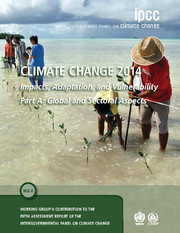 Climate Change 2014 – Impacts, Adaptation and Vulnerability: Part A: Global and Sectoral Aspects
Climate Change 2014 – Impacts, Adaptation and Vulnerability: Part A: Global and Sectoral Aspects Published online by Cambridge University Press: 05 January 2015
18.1. Introduction
This chapter synthesizes the scientific literature on the detection and attribution of observed changes in natural and human systems in response to observed recent climate change. For policy makers and the public, detection and attribution of observed impacts will be a key element to determine the necessity and degree of mitigation and adaptation efforts. For most natural and essentially all human systems, climate is only one of many drivers that cause change—other factors such as technological innovation, social and demographic changes, and environmental degradation frequently play an important role as well. Careful accounting of the importance of these and other confounding factors is therefore an important part of the analysis.
At any given location, observed recent climate change has happened as a result of a combination of natural, longer term fluctuations and anthropogenic alteration of forcings. To inform about the sensitivity of natural and human systems to ongoing climate change, the chapter assesses the degree to which detected changes in such systems can be attributed to all aspects of recent climate change. For the development of adaptation policies, it is less important whether the observed changes have been caused by anthropogenic climate change or by natural climate fluctuations. Where possible, the relative importance of anthropogenic drivers of climate change is assessed as well.
18.1.1. Scope and Goals of the Chapter
Previous assessments, notably in the IPCC Fourth Assessment Report (AR4; Rosenzweig et al., 2007), indicated that numerous physical and biological systems are affected by recent climate change. Owing to a limited number of published studies, human systems received comparatively little attention in these assessments, with the exception of the food system, which is a coupled human-natural system. This knowledge base is growing rapidly, for all types of impacted systems, but the disequilibrium remains (see also Section 1.1.1, Figure 1-1). The great majority of published studies attribute local to regional changes in affected systems to local to regional climate change.
To save this book to your Kindle, first ensure [email protected] is added to your Approved Personal Document E-mail List under your Personal Document Settings on the Manage Your Content and Devices page of your Amazon account. Then enter the ‘name’ part of your Kindle email address below. Find out more about saving to your Kindle.
Note you can select to save to either the @free.kindle.com or @kindle.com variations. ‘@free.kindle.com’ emails are free but can only be saved to your device when it is connected to wi-fi. ‘@kindle.com’ emails can be delivered even when you are not connected to wi-fi, but note that service fees apply.
Find out more about the Kindle Personal Document Service.
To save content items to your account, please confirm that you agree to abide by our usage policies. If this is the first time you use this feature, you will be asked to authorise Cambridge Core to connect with your account. Find out more about saving content to Dropbox.
To save content items to your account, please confirm that you agree to abide by our usage policies. If this is the first time you use this feature, you will be asked to authorise Cambridge Core to connect with your account. Find out more about saving content to Google Drive.